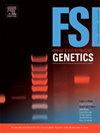Fourth-degree kinship analysis using 5198 single nucleotide polymorphisms detected by nanopore sequencing platform
IF 3.1
2区 医学
Q2 GENETICS & HEREDITY
引用次数: 0
Abstract
Nanopore sequencing technology has high portability and affordability of devices, long sequencing reads, and GB-level data yields. In forensic applications, nanopore sequencing has been used in the identification of forensic short tandem repeats (STRs) and single nucleotide polymorphisms (SNPs). Comparable to limited STRs, SNP markers have low per-locus discriminating power but are highly sufficient. Although numerous SNP panels consisting of thousands of loci have been developed, till now only ∼100 SNP panels have been evaluated using nanopore sequencing. In this study, we collected 24 DNA samples and employed a 9102 SNPs panel with hybridization capture for enrichment, followed by sequencing using Oxford Nanopore Technologies MinION device and SNP genotyping with NASTRA software. Parallel sequencing and genotyping were performed using Illumina NovaSeq, and we found the consistency of SNP genotypes with nanopore sequencing was over 99.3 %. Next, we filtered X or Y chromosomal markers, 3–6 multiple-allelic SNPs, and further excluded these failing Hardy-Weinberg Equilibrium (HWE) and Linkage Disequilibrium (LD), and obtained 5198 (57.1 %) SNPs. Based on the 5198 SNPs and likelihood ratio methods, 23 pairs of third-degree relatives were discriminated from the unrelated with a 100 % sensitivity and a 98.81 % specificity; 18 pairs of fourth-degree relatives had a 77.78 % sensitivity and 98.47 % specificity. The more close relatives were all correct in the kinship testing.
利用纳米孔测序平台检测5198个单核苷酸多态性进行四度亲缘关系分析
纳米孔测序技术具有高便携性和设备的可负担性,长测序读数和gb级数据产量。在法医应用中,纳米孔测序已被用于鉴定法医短串联重复序列(STRs)和单核苷酸多态性(SNPs)。与有限的str相比,SNP标记的单位点辨别能力较低,但足够。虽然已经开发了许多由数千个位点组成的SNP面板,但到目前为止,使用纳米孔测序仅评估了约100个SNP面板。在本研究中,我们收集了24份DNA样本,采用9102个SNP面板进行杂交捕获富集,然后使用Oxford Nanopore Technologies MinION设备进行测序,并使用NASTRA软件进行SNP基因分型。利用Illumina NovaSeq进行平行测序和基因分型,发现SNP基因型与纳米孔测序的一致性超过99.3 %。接下来,我们筛选X或Y染色体标记,3-6 多等位基因snp,并进一步排除这些不符合Hardy-Weinberg平衡(HWE)和连锁不平衡(LD)的snp,得到5198个(57.1% %)snp。基于5198个snp和似然比方法,将23对三度亲属与非亲属区分开来,敏感性为100 %,特异性为98.81 %;18对四度亲属敏感性77.78 %,特异性98.47 %。亲属关系检验中,亲属关系越近的均正确。
本文章由计算机程序翻译,如有差异,请以英文原文为准。
求助全文
约1分钟内获得全文
求助全文
来源期刊
CiteScore
7.50
自引率
32.30%
发文量
132
审稿时长
11.3 weeks
期刊介绍:
Forensic Science International: Genetics is the premier journal in the field of Forensic Genetics. This branch of Forensic Science can be defined as the application of genetics to human and non-human material (in the sense of a science with the purpose of studying inherited characteristics for the analysis of inter- and intra-specific variations in populations) for the resolution of legal conflicts.
The scope of the journal includes:
Forensic applications of human polymorphism.
Testing of paternity and other family relationships, immigration cases, typing of biological stains and tissues from criminal casework, identification of human remains by DNA testing methodologies.
Description of human polymorphisms of forensic interest, with special interest in DNA polymorphisms.
Autosomal DNA polymorphisms, mini- and microsatellites (or short tandem repeats, STRs), single nucleotide polymorphisms (SNPs), X and Y chromosome polymorphisms, mtDNA polymorphisms, and any other type of DNA variation with potential forensic applications.
Non-human DNA polymorphisms for crime scene investigation.
Population genetics of human polymorphisms of forensic interest.
Population data, especially from DNA polymorphisms of interest for the solution of forensic problems.
DNA typing methodologies and strategies.
Biostatistical methods in forensic genetics.
Evaluation of DNA evidence in forensic problems (such as paternity or immigration cases, criminal casework, identification), classical and new statistical approaches.
Standards in forensic genetics.
Recommendations of regulatory bodies concerning methods, markers, interpretation or strategies or proposals for procedural or technical standards.
Quality control.
Quality control and quality assurance strategies, proficiency testing for DNA typing methodologies.
Criminal DNA databases.
Technical, legal and statistical issues.
General ethical and legal issues related to forensic genetics.

 求助内容:
求助内容: 应助结果提醒方式:
应助结果提醒方式:


